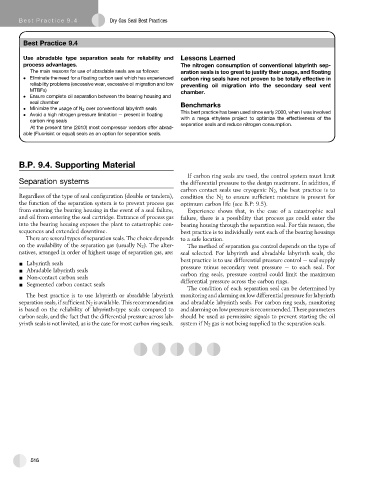Page 545 - Subyek Teknik Mesin - Forsthoffers Best Practice Handbook for Rotating Machinery by William E Forsthoffer
P. 545
Be st Practice 9 .4 Dry Gas Seal Best Practices
Best
Best
Best Practice 9.4Practice 9.4Practice 9.4
Use abradable type separation seals for reliability and Lessons Learned
process advantages. The nitrogen consumption of conventional labyrinth sep-
The main reasons for use of abradable seals are as follows: aration seals is too great to justify their usage, and floating
Eliminate the need for a floating carbon seal which has experienced carbon ring seals have not proven to be totally effective in
reliability problems (excessive wear, excessive oil migration and low preventing oil migration into the secondary seal vent
MTBFs) chamber.
Ensure complete oil separation between the bearing housing and
seal chamber
Minimize the usage of N 2 over conventional labyrinth seals Benchmarks
This best practice has been used since early 2000, when I was involved
Avoid a high nitrogen pressure limitation e present in floating
with a mega ethylene project to optimize the effectiveness of the
carbon ring seals
separation seals and reduce nitrogen consumption.
At the present time (2010) most compressor vendors offer abrad-
able (Fluorisint or equal) seals as an option for separation seals.
B.P. 9.4. Supporting Material
If carbon ring seals are used, the control system must limit
Separation systems the differential pressure to the design maximum. In addition, if
carbon contact seals use cryogenic N 2 , the best practice is to
Regardless of the type of seal configuration (double or tandem), condition the N 2 to ensure sufficient moisture is present for
the function of the separation system is to prevent process gas optimum carbon life (see B.P: 9.5).
from entering the bearing housing in the event of a seal failure, Experience shows that, in the case of a catastrophic seal
and oil from entering the seal cartridge. Entrance of process gas failure, there is a possibility that process gas could enter the
into the bearing housing exposes the plant to catastrophic con- bearing housing through the separation seal. For this reason, the
sequences and extended downtime. best practice is to individually vent each of the bearing housings
There are several types of separation seals. The choice depends to a safe location.
on the availability of the separation gas (usually N 2 ). The alter- The method of separation gas control depends on the type of
natives, arranged in order of highest usage of separation gas, are: seal selected. For labyrinth and abradable labyrinth seals, the
best practice is to use differential pressure control e seal supply
- Labyrinth seals
- Abradable labyrinth seals pressure minus secondary vent pressure e to each seal. For
- Non-contact carbon seals carbon ring seals, pressure control could limit the maximum
- Segmented carbon contact seals differential pressure across the carbon rings.
The condition of each separation seal can be determined by
The best practice is to use labyrinth or abradable labyrinth monitoring and alarming on low differential pressure for labyrinth
separation seals, if sufficient N 2 is available. This recommendation and abradable labyrinth seals. For carbon ring seals, monitoring
is based on the reliability of labyrinth-type seals compared to and alarming on low pressure is recommended. These parameters
carbon seals, and the fact that the differential pressure across lab- should be used as permissive signals to prevent starting the oil
yrinth seals is not limited, as is the case for most carbon ring seals. system if N 2 gas is not being supplied to the separation seals.
516

